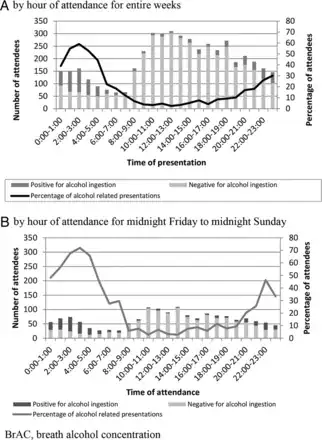No. Unless the weekend is redefined to cover a few quiet hours on friday and saturday night.
The sensational newspaper headlines are based on a relatively reliable piece of research which is consistent with previous research done both in the UK and in some other countries.
The language used in the research paper and the way data is presented somewhat obfuscate the results and lead to a temptation to quote sensational but insignificant results rather than the overall conclusion (of course, this might be a deliberate attempt by the paper's authors to get attention in newspapers).
The abstract reports the following:
The prevalence rates of alcohol related attendances were 12% and 15% for the retrospective and prospective cohorts, respectively. Prospectively, the rates ranged widely from 4% to 60% across week days, rising to over 70% at weekends.
This requires some explanation. The 12% is the ratio of people attending who have taken alcohol to total attenders over the observation periods. The higher 15% number is adjusted to account for future attendance outside the observation periods (and basically means that people who have attended once with alcohol-related issues are more likely to re-attend within a year). The vastly higher numbers are not the percentage of alcohol related attenders at the whole weekend, but the maximum ratio for any hour of the day. Alcohol-related attendance is focussed between the hours of midnight-4am which are also the quietest hours in typical emergency departments. So the percentage is a percentage of a low base and not at all representative of the whole day.
Here are two charts from the paper that illustrate this:

To summarise the results: even at the weekend, alcohol-related admissions are low when general attendance is high, but high when attendance is low. So the proportion of alcohol-related attendance varies across the day with a peak in the early morning of about 70%. For the whole weekend, though, only about 15% of attendance is related to the demon booze.
Quoting the maximum hourly rate of alcohol-related attends greatly exaggerates the problem (and guarantees, perhaps, press attention). The paper actually makes it quite hard to see the complete picture for the whole weekend (the charts are the only place the data are presented in a clear and complete form).
The numbers may also be exaggerated by the choice to include other attendance by the same people outside the sample (the "prospective" cohort). It isn't clear from the method they use what the base is for the larger percentages in this cohort. It may exaggerate or it may not; it is hard to tell.
There is another problem with the paper's method. They use a positive breath test to categorise whether an attendance is alcohol-related. This doesn't clearly link the reason for attendance to to consumption of alcohol. This might not be a cause of exaggeration, especially in Newcastle which has a heavy weekend drinking culture, but it is impossible to be sure.
Summary
The high numbers quoted in headlines are highly selective. It might be reasonable to say that 15% of attendances at weekends are from people who have recently consumed alcohol. In some or many of these cases the attendance will be indirectly caused by alcohol (e.g. falls). The 70% number comes from a highly selective view covering only a small percentage of the weekend where few people attend A&E anyway.
Update
BBC Radio 4's weekly programme More or Less (which studies dubious claims in headlines) mostly agrees with the analysis above. The podcast is here (section starts at about 15m:30s). The programme clarifies what is meant (talking to the original researchers) and criticises them for fuzzy language that could be easily misinterpreted.
